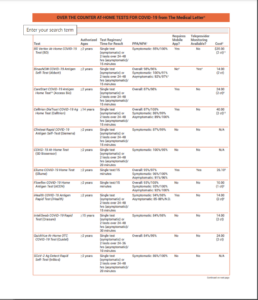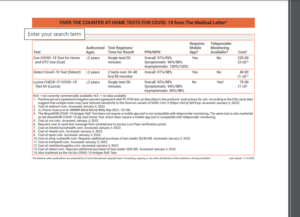When it comes to nasal swabs, it is better to give than to receive. The hundreds of patients that I have swabbed should be grateful that I have been on both ends of the swab. It does change your perspective. The above was taken in Paris when I was getting swabbed in November for my Pass Sanitaire.
This was a review in this morning’s online paper about PCR versus antigen testing which I thought was a nice overview. it would be even nicer if they could tell you where to buy at home tests. Following that is a review of the different at home tests on the market from The Medical Letter.
PCR vs. antigen testing: what’s the difference, and what should you buy?
We spoke to experts to get real answers.

Two years into the pandemic, we’re getting some solid testing options finally available on a widespread basis — never mind that shortage of at-home rapid antigen tests (RATs) that happened over the duration between Christmas and New Year’s. But PCR tests and RATs remain on the pricey side, so you don’t want to spend your money on the wrong kind of test for the wrong reasons.
“PCR (polymerase chain reaction) and antigen tests — both of which typically use nasal swabs to collect samples — differ in detection methods, processing, and turnaround times,” says Dr. Ariella Morrow from Sameday Health, a personalized healthcare provider with nationwide covid-testing clinic and services. :
We’ve spoken to her and other medical experts about the differences between a PCR and RAT—as well as what situations you should use either kind of test for.
What is the difference between a PCR and an antigen test?
Each test uses a different process to detect the presence of Covid-19 in your body, with PCR tests taking a super-thorough look — if you have Covid, there’s a greater chance you’ll test positive with a PCR test than with a rapid antigen test, says Erica Susky, an infection control practitioner in hospital epidemiology, making them the best accessible way to tell if you have COVID or not.
“PCRs, a molecular test, look for the virus’ genetic material within the specimens sample, which is then processed in a lab (often resulting in a longer turnaround time),” says Morrow. “These are the most accurate tests available due to their high sensitivity, and thus, the most widely used form of covid test by the medical community. Meanwhile, antigen tests search for a piece of the virus’ protein in the sample, which can then be analyzed by a healthcare professional in real-time or at home.”
Rapid antigen tests (RAT) are easier to perform because anyone can do one at home and it’s faster obtain results, says Susky. They usually take about 15 to 30 minutes for results.
“Although antigen tests typically provide results in under fifteen minutes,” says Marrow, “they are more likely to yield false-negative results due to lesser sensitivity, especially for those that are asymptomatic.”
While most people perform their own antigen tests, PCR tests are almost always administered by someone else, with samples sent to a lab for detection and analysis. “This test takes more time as it is required to be done by trained laboratory professionals,” says Susky. “Wait times can be as much as 72 hours for PCR results.”
What’s the science behind PCR and antigen tests?
“PCR (or polymerase chain reaction) amplifies targeted regions of a genome,” says Erica Susky, an infection control practitioner in hospital epidemiology. “In the case of SARS-CoV-2, as the viral genome is made of RNA, there are pieces of RNA primer made in the laboratory designed to bind to areas of the SARS-CoV-2 sequence with the intention of amplifying them. The chain reaction entails temperature cycling that allow the targeted pieces of SARS-CoV-2 to be amplified so they will then be easily detected, usually with fluorescent dyes.”
Since this involves amplification of parts of the SARS-CoV-2 virus, “RATs work by binding antigens to antibodies,” says Susky. “Antibodies are made by the immune system and function by binding select targets. One gets a nasal or throat specimen and puts it in a liquid buffer”— i.e. you swab your nose and then swirl it around some liquid that comes with the test kit. “The buffer is flooded onto the RAT slide,” she says. “The RAT slide contains SARS-CoV-2 antigens bound to a color marker.”
If you have Covid, then the antibodies from the virus bind to the color-marked antigen in the test and you’ll see a colored band.
PCR vs. antigen: Which one is more accurate?
PCR tests are ultimately the more accurate way to tell if you have COVID-19, but antigen tests are a great first line of defense if you think you have symptoms. It’s best to use PCR tests, rather than antigen tests, before higher-risk situations for you and others or when legally required, like before a flight.
Susky says PCR testing “is much more sensitive than antigen testing. What this means is that with someone who has COVID-19, there is a greater chance that they will test positive by PCR than with the antigen test, or there are fewer chances of false negative results.”
On the other hand, “rapid antigen tests are not as sensitive as PCR — there’s a higher chance of testing negative when one may in fact have COVID-19, but they are quite specific,” Susky says. “Something with a good specificity means that a positive result has a high probability of the presence of disease. Therefore, if one tests positive by RAT it is safe to say they have COVID-19 and should isolate at home.”
Where can you buy antigen and PCR tests?
Because PCR tests require the use of a lab, the easiest way to get a PCR test is to book it with a test provider — just be prepared to fork out some money for it. Antigen tests are now widely available and come in at less than $18 for two on sites like Amazon, which isn’t cheap but a lot better than spreading COVID-19.


Here is the link which should be easier to read.
https://secure.medicalletter.org/downloads/5041a_table.pdf
FOE THOSE THAT WANT EVEN MORE DETAIL, HERE IS A LINK TO LAST WEEK’S NEW ENGLAND JOURNAL OF MEDICINE ON RAPID DIAGNOSTIC TESTING FOR COVID 19. https://www.nejm.org/doi/full/10.1056/NEJMcp2117115?query=recirc_mostViewed_railB_article



